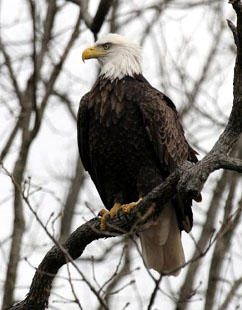Kentucky’s bald eagle population continues to rise as new nests appear throughout the Commonwealth.
The Kentucky Department of Fish and Wildlife reports there are 187 active bald eagle nests in the state. That’s an increase from 174 in 2018. The number of nests has tripled since 2010, where 62 nests were active.

Kate Slankard is an ornithologist with the Department of Fish and Wildlife. She said the recent population boom occurred with no intervention from the state.
“All of the population increase from the past twenty years or so has been natural,” she said. “The birds were naturally reproducing themselves. We’re not releasing bald eagles anymore. This is nature providing this increase.”
The Commonwealth’s bald eagles have rebounded from a population of zero prior to 1986. Wildlife experts say the population rise can partially be explained by the federal ban of a pesticide called dichlorodiphenyltrichloroethane, or DDT.
Land Between the Lakes Lead Naturalist John Pollpeter told WKMS in an interview last year the DDT harmed the offspring of bald eagles.
“The DDT would get concentrated in their body and then it would make their eggshells very weak and thin. So when the eagles would incubate them, they would often crush the eggs and harm the chicks, possibly killing them,” said Pollpeter.
The federal government intervened to ban DDT in 1972, when Environmental Protection Agency Administrator William D. Ruckelshaus issued an order canceling all federal registrations of DDT products.
While EPA action came in the 1970’s, statutory protection for bald eagles first began decades earlier. 1940’s Bald and Gold Eagle Protection Act was the first law enacted to assist in bald eagle preservation. The act prohibits anyone without a permit from “taking” bald eagles.
In 1973, one year after the federal order banning DDT, Congress passed the Endangered Species Act. Bald eagles were included as a protected species under the provisions of the act. The Endangered Species Act was passed with a mission to “provide a means whereby the ecosystems upon which endangered species and threatened species depend may be conserved.”
A total of four laws were passed throughout the mid-twentieth century that included the preservation of bald eagles in their goals. Throughout the 1980’s and 1990’s, the United States Fish and Wildlife Service published detailed conservation plans for bald eagles throughout the country. The plans provided region-specific guidelines for improving bald eagle populations.
Kentucky was included under 1982’s Southeastern Bald Eagle Recovery Plan. The plan presented statistics on nesting sites throughout southeastern states including Kentucky and Tennessee.
Statutory protections, the federal prohibition of DDT and plans from the Fish and Wildlife Service all proved successful when bald eagles were removed from the endangered species list in 2007.
Kentucky ornithologist Kate Slankard said she expects the increases in eagle population to continue over the coming years.
“We still have a positive trend,” said Slankard. “We expect to see that for several more years. We think there’s still space to fill when it comes to bald eagle habitats in Kentucky.”
The bald eagle has been the official bird of the United States of America since June 20, 1782.
(This report first ran on WKMS.org.)





